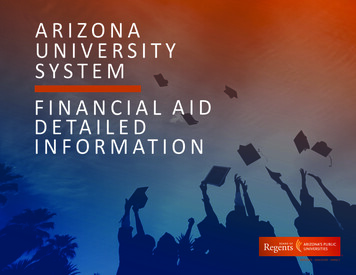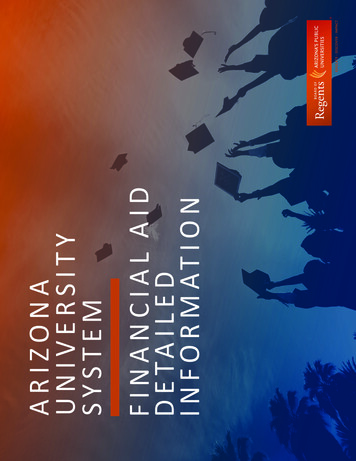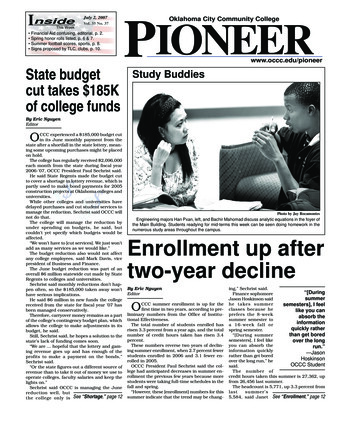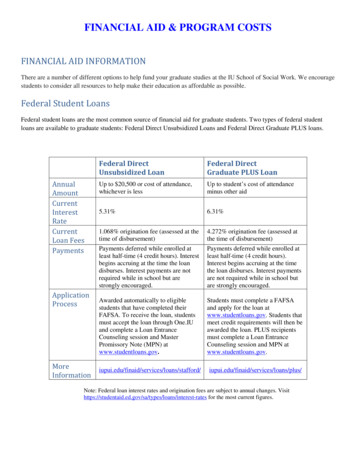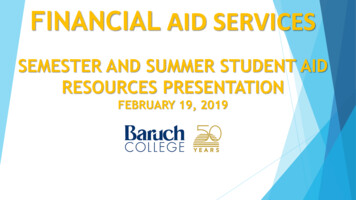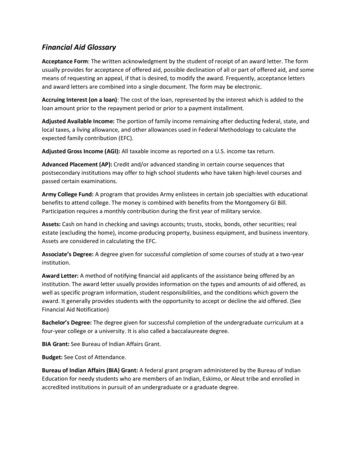
Transcription
Financial Aid GlossaryAcceptance Form: The written acknowledgment by the student of receipt of an award letter. The formusually provides for acceptance of offered aid, possible declination of all or part of offered aid, and somemeans of requesting an appeal, if that is desired, to modify the award. Frequently, acceptance lettersand award letters are combined into a single document. The form may be electronic.Accruing Interest (on a loan): The cost of the loan, represented by the interest which is added to theloan amount prior to the repayment period or prior to a payment installment.Adjusted Available Income: The portion of family income remaining after deducting federal, state, andlocal taxes, a living allowance, and other allowances used in Federal Methodology to calculate theexpected family contribution (EFC).Adjusted Gross Income (AGI): All taxable income as reported on a U.S. income tax return.Advanced Placement (AP): Credit and/or advanced standing in certain course sequences thatpostsecondary institutions may offer to high school students who have taken high-level courses andpassed certain examinations.Army College Fund: A program that provides Army enlistees in certain job specialties with educationalbenefits to attend college. The money is combined with benefits from the Montgomery GI Bill.Participation requires a monthly contribution during the first year of military service.Assets: Cash on hand in checking and savings accounts; trusts, stocks, bonds, other securities; realestate (excluding the home), income-producing property, business equipment, and business inventory.Assets are considered in calculating the EFC.Associate’s Degree: A degree given for successful completion of some courses of study at a two-yearinstitution.Award Letter: A method of notifying financial aid applicants of the assistance being offered by aninstitution. The award letter usually provides information on the types and amounts of aid offered, aswell as specific program information, student responsibilities, and the conditions which govern theaward. It generally provides students with the opportunity to accept or decline the aid offered. (SeeFinancial Aid Notification)Bachelor’s Degree: The degree given for successful completion of the undergraduate curriculum at afour-year college or a university. It is also called a baccalaureate degree.BIA Grant: See Bureau of Indian Affairs Grant.Budget: See Cost of Attendance.Bureau of Indian Affairs (BIA) Grant: A federal grant program administered by the Bureau of IndianEducation for needy students who are members of an Indian, Eskimo, or Aleut tribe and enrolled inaccredited institutions in pursuit of an undergraduate or a graduate degree.
Business Assets: Property that is used in the operation of a trade or business, including real estate,inventories, buildings, machinery and other equipment, patents, franchise rights, and copyrights.Business assets are considered in the calculation of the EFC under the regular formula.Campus-Based Programs: The term commonly applied to those federal student aid programsadministered directly by institutions of postsecondary education. Campus-based programs include:Federal Perkins Loan, Federal Supplemental Educational Opportunity Grant (FSEOG), and FederalWorkStudy (FWS).Capitalization (of interest): The arrangement between borrower and lender whereby interest paymentsare deferred as they come due and are added to the principal amount of the loan.Central Processing System (CPS): The computer system to which the student’s need analysis data iselectronically transmitted by the Free Application for Federal Student Aid (FAFSA) processor. The CentralProcessing System performs database matches, calculates the student’s official EFC, and generates theStudent Aid Report (SAR).Certificate: The formal acknowledgment of successful completion of a particular program or course ofstudy, particularly at a vocational school, trade school, or junior college.CLEP: See College-Level Examination Program.COA: See Cost of Attendance.College-Level Examination Program (CLEP): A series of examinations demonstrating a student’sproficiency in a subject area, for which some postsecondary institutions offer credit.Commuter Student: A student who does not live on campus; typically, “commuter” refers to a studentliving at home with his or her parents, but can also mean any student who lives off campus.Consolidation Loan: A loan made to enable a borrower with different types of loans or multiple loans toobtain a single loan with one interest rate and one repayment schedule. Federal Perkins Loans, DirectSubsidized and Direct Unsubsidized Loans, Health Education Assistance Loans (HEAL), Health ProfessionsStudent Loans (HPSL), and Loans for Disadvantaged Students may be combined for purposes ofconsolidation, subject to certain eligibility requirements. A consolidation loan pays off the existing loans;the borrower then repays the consolidated loan.Cooperative Education: A program through which a college student alternates periods of classroominstruction with periods of related employment.
Cost of Attendance (COA): The estimated cost of attending this institution for one academic year. Thisamount includes the following: Expected charges for one year of tuition and feeso Tuition – Charges assessed for classeso Fees – Charges assessed for other college servicesRoom and board for resident studentsEstimated living expense -- allowance for rent, utilities, and food for off-campus livingEstimated transportation costsEstimated books and suppliesMiscellaneous costsCPS: See Central Processing System.Credit (or Credit Hour): The unit of measurement some institutions give for fulfilling courserequirements.Custodial Parent: The parent with whom a dependent student lives, and whose financial information isused in need analysis when parents are divorced or separated.Deferment (of loan): A condition during which payments of principal are not required, and for FederalPerkins Loans and Direct Subsidized Loans, interest does not accrue. The repayment period is extendedby the length of the deferment period.Department of Education, U.S. (ED): The federal government agency that administers assistance tostudents enrolled in postsecondary educational programs under the following programs: Federal PellGrant, Iraq and Afghanistan Service Grant (IASG); Teacher Education Assistance for College and HigherEducation (TEACH) Grant, Federal Perkins Loan, Federal Supplemental Educational Opportunity Grant(FSEOG), Federal Work-Study (FWS), and William D. Ford Federal Direct Loan (Direct Loan) Program.Departmental Scholarship: An award of gift assistance that is specifically designated for a recipient in aparticular academic department within the institution.Dependent Student: A student who does not qualify as an independent student and whose parentalincome and asset information is used in calculating the EFC (see Independent Student).Direct Costs: Expenses the student/family pays to the college.Direct PLUS Loan: Long-term loans made available to parents of dependent students andgraduate/professional students. Interest rates are fixed at 7.9 %. May be used to replace EFC; amountborrowed is limited to the cost of attendance minus estimated financial assistance.Direct Subsidized and Direct Unsubsidized Loans: Long term, low-interest loans administered by theDepartment of Education and institutions. Loans carry a fixed interest rate. Direct Unsubsidized Loanscan be used to replace EFC.
Educational Benefits: Funds, primarily federal, awarded to certain categories of students (veterans,children of deceased veterans or other deceased wage earners, and students with physical disabilities)to help finance their postsecondary education regardless of their ability to demonstrate need in thetraditional sense.Educational Expenses: See Budget and Cost of Attendance.Educational Loan: A form of financial aid that must be repaid with interest. Educational loans havevarying interest rates and repayment terms. Students and/or parents are required to sign a promissorynote when accepting an educational loan.EFC: See Expected Family Contribution.Employment: With reference to financial aid, the opportunity for students to earn money to help payfor their education. FWS is one program by which needy students can work to help pay their educationalexpenses.Employment Allowance: An allowance to meet expenses related to employment when both parents (ora married independent student and spouse) are employed or when one parent (or independent student)qualifies as a surviving spouse or as head of a household. It is used in the need analysis formula forparents and student, if eligible.Enrollment Level: Level of the degree-granting program in which a student is enrolled. Basic levels ofenrollment include: undergraduate (students seeking an associate's degree, a certificate, or abaccalaureate degree); post-baccalaureate (such as teacher certification); graduate (students workingon a master's degree or professional degree); and post-graduate (such as students enrolled in a doctoralprogram). The amounts and types of financial aid a student is eligible for is determined, in part, by theirenrollment level.Enrollment Status: Academic workload (or course load), as defined by the institution, that a student iscarrying for a defined academic period. This normally relates to the number of credit hours or clockhours taken by a student during a given academic period. For most traditional undergraduate termbased schools: Full-time status at least 12 credit hoursThree-quarter time status at least 9-11 credit hoursHalf-time status at least 6-8 credit hours.For most clock hour schools full-time enrollment equates to at least 24 clock hours per week.Estimated Financial Assistance (EFA): The total assistance that a student is receiving to offset the cost ofa postsecondary education, including scholarships, Title IV aid, need-based work assistance, and privateloans, that is subtracted from a student’s need when determining eligibility for campus-based aid, DirectSubsidized and Unsubsidized Loans, and PLUS.Expected Family Contribution (EFC): The amount a student and his or her family is expected tocontribute toward the student’s cost of attendance as calculated by a Congressionally-mandatedformula known as Federal Methodology. The EFC is used to determine a student’s eligibility for thestudent financial assistance programs.
FAFSA: See Free Application for Federal Student Aid.FAFSA4Caster: Allows students and families to input financial information and receive an estimate oftheir federal aid eligibility before filing the FAFSA.FAFSA on the Web (FOTW): Allows students to complete and file a FAFSA on-line at www.fafsa.gov.Federal Direct Student Loan (Direct Loan) Program: The collective name for the Direct Subsidized,Direct Unsubsidized, Direct PLUS, and Direct Consolidation Loan Programs. Loan funds for theseprograms are provided by the federal government to students and parents through postsecondaryinstitutions.Federal Methodology (FM): A standardized method for determining a student’s (and family’s) ability topay for postsecondary education expenses. The single formula for determining an EFC for Federal PellGrants, campus-based programs, and Direct Loan programs; the formula is defined by law.Federal Pell Grant: A federal grant program for needy postsecondary students who have not yetreceived a baccalaureate or first professional degree; administered by the U.S. Department ofEducation.Federal Perkins Loan: One of the campus-based programs; a long term, low interest loan program forboth undergraduate and graduate students at a current interest rate of 5%. At one time it was known asthe Carl D. Perkins National Direct Student Loan Program (NDSL).Federal Supplemental Educational Opportunity Grant (FSEOG): One of the campus-based programs;grants to undergraduate students of exceptional financial need who have not completed their firstbaccalaureate degree and who are financially in need of this grant to enable them to pursue theireducation. Priority for FSEOG awards must be given to Federal Pell Grant recipients with the lowestEFCs.Federal Work-Study (FWS) Program: One of the campus-based programs; a part-time employmentprogram which provides jobs for undergraduate and graduate students who are in need of earnings tomeet a portion of their educational expenses.Financial Aid: General term that describes any source of student assistance outside of the student or thestudent’s family. Funds awarded to a student to help meet postsecondary educational expenses. Thesefunds are generally awarded on the basis of financial need and include scholarships, grants, loans, andemployment.Financial Aid Administrator: An individual who is responsible for preparing and communicatinginformation pertaining to student loans, grants or scholarships, and employment programs, and foradvising, awarding, reporting, counseling, and supervising office functions related to student financialaid. A financial aid administrator is accountable to the various federal, state, and institutional entitiesthat provide aid and interprets and implements federal, state, and institutional policies and regulations,and is capable of analyzing student and employee needs and making changes where necessary.Financial Aid Award: An offer of financial or in-kind assistance to a student attending a postsecondaryeducational institution. This award may be in the form of one or more of the following types of financialaid: repayable loan, a non-repayable grant and/or scholarship, and/or student employment.
Financial Aid Consultant: A person who, for a fee, provides a variety of services to students and parents,including preparing the FAFSA and other financial aid forms, estimating the EFC, and estimating financialneed.Financial Aid Notification: The letter from a postsecondary institution that lets the student knowwhethe
the Carl D. Perkins National Direct Student Loan Program (NDSL). Federal Supplemental Educational Opportunity Grant (FSEOG): One of the campus-based programs; grants to undergraduate students of exceptional financial need who have not completed their first


